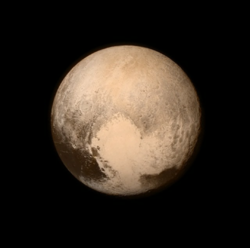Difference between revisions of "Pluto"
From FenWiki
(added NASA-JPL text about Pluto) |
m |
||
| (10 intermediate revisions by 2 users not shown) | |||
| Line 1: | Line 1: | ||
{{stub}} | {{stub}} | ||
| + | {{planetbox | ||
| + | |name = 134340 Pluto | ||
| + | |image = Pluto.png | ||
| + | |caption = The planet Pluto, as imaged by [[Artemis Foundation]] researchers in 2015. | ||
| + | |orbit = semi-major axis 39.54 AU, eccentricity 0.24905 | ||
| + | |diameter = 1,187±4 km | ||
| + | |gravity = 0.063g | ||
| + | |year = 90,581 days (248.00 Earth years) | ||
| + | |day = 153.2933 hours | ||
| + | |temp = mean 44°K | ||
| + | |atmosphere = nitrogen, methane, carbon monoxide<br />1 Pa (summer maximum) | ||
| + | |waterice = | ||
| + | |population = | ||
| + | |political = [[Fenspace Convention]] | ||
| + | |government = Meritocracy | ||
| + | |capital = [[Hades Station]] | ||
| + | }} | ||
| − | + | :''"It has a heart! Why does it have a heart?"''<br />''"Because it loves us. And we love it."'' | |
| − | + | ||
| − | + | ||
| − | '' | + | '''134340 Pluto''' was discovered by Clyde W. Tombaugh on February 18, 1930. It is named after one of the alternate names of Hades, the Greek god of the Underworld. |
| − | + | Pluto has at least five natural satellites, '''Charon''', '''Styx''', '''Nix''', '''Kerberos''', and '''Hydra''', and one artificial satellite, '''[[Hades Station]]'''. | |
==Places of Interest== | ==Places of Interest== | ||
| − | Pluto is host to '''[[Hades Station]]''', a research base set at the Pluto-Charon L3 point to study [[Cochrane's Limit]]. | + | Pluto is host to '''[[Hades Station]]''', a research base set at the Pluto-Charon L3 point to study [[Cochrane's Limit]] and many other things of interest. |
| − | {{places}} | + | {{places}}[[Category:Trans-Neptunian Objects]] |
| − | + | ||
| − | + | ||
| − | [[Category:Trans-Neptunian Objects | + | |
| − | + | ||
Latest revision as of 15:11, 1 May 2016
 This Fenspace article is a stub. You can help FenWiki by expanding it.
This Fenspace article is a stub. You can help FenWiki by expanding it.
| 134340 Pluto | |
 The planet Pluto, as imaged by Artemis Foundation researchers in 2015. | |
| Planetary characteristics | |
|---|---|
| Orbit | semi-major axis 39.54 AU, eccentricity 0.24905 |
| Diameter | 1,187±4 km |
| Surface Gravity | 0.063g |
| Year | 90,581 days (248.00 Earth years) |
| Day | 153.2933 hours |
| Mean Temperature | mean 44°K |
| Atmosphere | nitrogen, methane, carbon monoxide 1 Pa (summer maximum) |
| Political Affiliation | Fenspace Convention |
| Government | Meritocracy |
| Capital | Hades Station |
- "It has a heart! Why does it have a heart?"
"Because it loves us. And we love it."
134340 Pluto was discovered by Clyde W. Tombaugh on February 18, 1930. It is named after one of the alternate names of Hades, the Greek god of the Underworld.
Pluto has at least five natural satellites, Charon, Styx, Nix, Kerberos, and Hydra, and one artificial satellite, Hades Station.
Places of Interest
Pluto is host to Hades Station, a research base set at the Pluto-Charon L3 point to study Cochrane's Limit and many other things of interest.